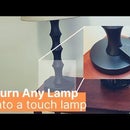Introduction: Hacking USB Power Banks to Power Arduino
Using inexpensive power banks to power your Arduino circuits is so frustrating with their low current, auto-off circuitry.
If the power bank doesn't detect a significant enough power load -- they just shut down after 30-40 seconds. Let's modify a Charge Doctor device to overwrite this annoying power-saving feature.
I build a ton of small circuits that draw only a few mA of current and want to be able to power them from simple rechargeable power banks that we all have laying around. In today's Instructable, we will modify a Charge Doctor to stay on forever.
We are going to add two resistors over the power and ground pins to cause a small load on the power bank that will trick it into staying on as long as this Charge Doctor is plugged in.
Supplies
Let's collect up the components we'll need:
- Power Bank (any will do - I like these too or make your own)
- Charge Doctor (this style works best, but others will work as well)
- Two 200 Ohm resistors (1/4 watt in size)
- Soldering Station
- Some solder (this is good quality solder)
- Polyimide High-Temperature Tape (aka. Kapton Tape) (could use electrical tape or hot-glue as well)
Step 1: Opening Our Charge Doctor
The Charge Doctors that I have are clipped together using four small clips, making them very easy to open and modify.
Using a small screwdriver, carefully separate the clips without breaking them off. Take your time; it will come apart.
Once apart, you will notice that there is a piece of protective film over the LED display. Now is a great time to remove it and improve the view through the gray plastic cover.
Also, note that we have a lot of extra space on the bottom half of the Charge Doctor to add resistors.
Step 2: Testing the Resistor Values
Using a multimeter, identify which pins are the 5V and GND of your USB plug. This will be the same on all USB plugs, but if you are not familiar with the pin layout, it is a good idea to check.
In my testing, I found that we want to add a 100 Ohm resistance across the 5V and GND pins - we'll talk about the power dissipation in a minute.
At this step, you can tack on a 100 Ohm resistor in place and test it with your power bank. You can use a 100 Ohm resistor or two 200 Ohm resistors in parallel, as I have done here.
You may have a power bank that will need a different resistor value. If that is the case, try decreasing the resistor values and then check the power dissipation, as we will do in the next step.
Step 3: Measuring the Power
Before we commit to our final resistor values, let's run the math on our power dissipation and make sure we are within the specification of our 1/4 watt resistors.
Using Ohm's Law, let's calculate the current:
I = V/R (Ohm's law) V = 5V R = 100Ohm I = 5/100 = 50mA
50mA is current across our load, now let's calculate the power:
P = 5V * 50mA = 250mW or 1/4 Watt
Using one 100 Ohm resistor would dissipate 1/4 watt which is within range of our resistors specifications.
However, to be on the safe side since it is enclosed within the plastic case, let's use two 200 Ohm resistors in parallel. This configuration will give us 100 Ohm but with 1/2 watt dissipation.
Step 4: Final Resistor Placement
Now that we know our final resistor value needs to be 100 Ohm, let's go ahead and solder it in place.
Since the solder on the original joints are probably lead-free solder, heat the existing solder joints and flow in some fresh solder, this will make it a lot easier to work with. If you want, you can completely remove the old solder and start fresh, but it is not necessary.
I twisted the two 200 Ohm resistors together and soldered them in place.
Be careful not to cause a solder bridge between the other pins, which are very close. Also, keep the resistor's leads from touching the rest of the circuit as it will short out the entire board.
In the final step, we will add some Kapton tape to protect the resistors.
Step 5: Adding Some Tape
Add a small piece of polyimide high-temperature tape (Kapton tape) around and between the resistor's leads to prevent them from shorting out. If they do short out, it will likely trigger the short-circuit protection in the power bank, and the circuit will shut off entirely.
If you do not have polyimide tape, simple black electrical tape will work, or you could use hot glue to hold the leads in place and prevent them from touching the board.
I also like to mark my Charge Doctor to indicate that they have been modified. Place a small piece of yellow tape on the back of the charge doctor as an indicator.
Step 6: Testing & Completed Hack
Test your newly modified Charge Doctor with your power banks. And now it won't power down on you.
I tested my modified charge doctor in five different power banks and it worked great for all of them.
Enjoy the hack and post pictures of your versions below.













